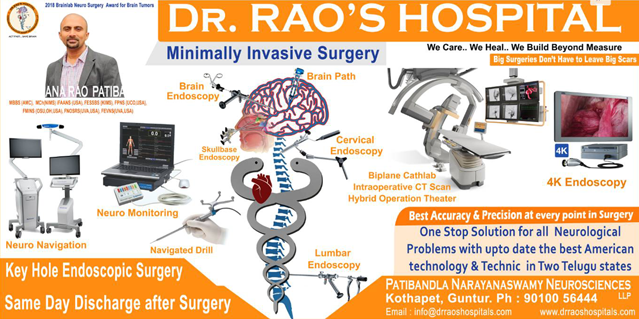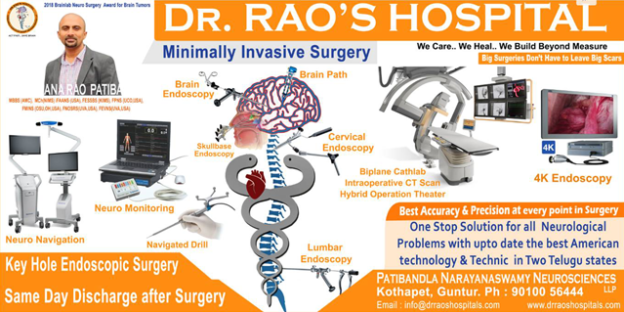Tarlov’s cyst – the best treatment at Dr Raos, Guntur
Introduction
A Tarlov’s cyst is a type of spinal cyst that can pressure the nerves in your spine. This can cause pain, tingling, or numbness in your legs or buttocks. You might also have weakness in your legs. Tarlov’s cysts are also called perineural cysts. They’re usually benign, which means they’re not cancerous. But they can still cause problems. Tarlov cysts are most common in women between 30 and 50. They’re more likely to happen if you have a family history of them. They can occur anywhere along your spine, but they’re most often found in the lower (lumbar) or sacral region. Looking for the best Tarlov’s treatment look no further than Dr Raos hospital, Guntur, Andhra Pradesh and Dr Rao is the best spine cord injury specialist. contact us @9010056444 or 9010057444.
causes
There are a number of possible causes of Tarlov cysts, though the exact cause is not yet known. It is thought that they may be the result of abnormal development of the spinal nerves or changes in the structure of the spine. They may also be caused by trauma to the spine or by infection.
Symptoms
Symptoms of Tarlov cysts can vary depending on the size and location of the cyst. Some people may not have any symptoms at all. Others may experience pain, numbness, or tingling in the affected area. The pain is often described as a dull ache that gets worse with sitting or standing for long periods. It may also get worse with coughing, sneezing, or straining. Sometimes, the pain can be severe enough to interfere with daily activities.
If the cyst is large or presses on the spinal cord or nerves, it can cause weakness, loss of sensation, or paralysis in the legs or arms. Urinary and bowel problems may also occur if the cyst presses on the nerves that control these functions.
diagnosis
A Tarlov cyst is typically diagnosed using magnetic resonance imaging (MRI). This imaging technique can provide clear pictures of the spinal cord and nerves and any abnormal growths or fluid-filled areas. In some cases, a computed tomography (CT) scan may also be ordered to get a more detailed view of the cyst.
If a Tarlov cyst is suspected, your doctor will likely order an MRI of your spine. This imaging test can give your doctor a clear picture of your spinal cord and nerves and any abnormal growths or fluid-filled areas. In some cases, a CT scan may also be ordered to get a more detailed view of the cyst.
treatment – conservative and minimally invasive spine surgery
There are two main types of treatment for Tarlov cysts: conservative and minimally invasive spine surgery.
Conservative treatment includes pain medication, physical therapy, and epidural injections. This treatment is typically used to help relieve symptoms and improve quality of life. It is important to note that conservative treatment does not usually cure Tarlov cysts.
Minimally invasive spine surgery is a newer treatment that has shown promise in treating Tarlov cysts. This type of surgery is less invasive than traditional open spine surgery, which means there is less risk of complications and a shorter recovery time. Minimally invasive spine surgery typically involves placing a small tube called a shunt into the cyst to drain it of fluid. This can help to reduce pressure on the nerves and relieve symptoms.
outcome
The outcome of Tarlov cysts is generally good. Most people with Tarlov cysts do not experience any symptoms and do not require treatment. However, some people may experience pain, numbness, or weakness if the cyst presses on a nerve. In rare cases, the cyst may rupture and cause spinal cord damage. Treatment is typically only necessary if the cyst is causing symptoms.
Conclusion
The Tarlov cyst is a debilitating condition that can cause a great deal of pain and suffering for those affected by it. While there are treatments available, there is no cure for the condition and it can often recur. For this reason, it is important for patients to be as informed as possible about the condition and its potential treatments. Looking for the best Tarlov’s treatment look no further than Dr Raos hospital, Guntur, Andhra Pradesh and Dr Rao is the best spine cord injury specialist. contact us @9010056444 or 9010057444.
పరిచయం
టార్లోవ్ తిత్తి అనేది మీ వెన్నెముకలోని నరాలపై ఒత్తిడి తెచ్చే వెన్నెముక తిత్తి రకం. ఇది మీ కాళ్ళు లేదా పిరుదులలో నొప్పి, జలదరింపు లేదా తిమ్మిరిని కలిగిస్తుంది. మీ కాళ్ళలో కూడా బలహీనత ఉండవచ్చు. టార్లోవ్ సిస్ట్లను పెరిన్యురల్ సిస్ట్లు అని కూడా అంటారు. అవి సాధారణంగా నిరపాయమైనవి, అంటే అవి క్యాన్సర్ కావు. కానీ అవి ఇప్పటికీ సమస్యలను కలిగిస్తాయి.
30 మరియు 50 సంవత్సరాల మధ్య వయస్సు గల స్త్రీలలో టార్లోవ్ సిస్ట్లు సర్వసాధారణం. మీరు వారి కుటుంబ చరిత్రను కలిగి ఉన్నట్లయితే అవి సంభవించే అవకాశం ఉంది. అవి మీ వెన్నెముకలో ఎక్కడైనా సంభవించవచ్చు, కానీ అవి చాలా తరచుగా దిగువ (కటి) లేదా పవిత్ర ప్రాంతంలో కనిపిస్తాయి.
కారణాలు
టార్లోవ్ సిస్ట్లకు అనేక కారణాలు ఉన్నాయి, అయితే ఖచ్చితమైన కారణం ఇంకా తెలియలేదు. అవి వెన్నెముక నరాల యొక్క అసాధారణ అభివృద్ధి లేదా వెన్నెముక నిర్మాణంలో మార్పుల ఫలితంగా ఉండవచ్చని భావిస్తున్నారు. అవి వెన్నెముకకు గాయం లేదా ఇన్ఫెక్షన్ వల్ల కూడా సంభవించవచ్చు.
లక్షణాలు
తిత్తి పరిమాణం మరియు స్థానాన్ని బట్టి టార్లోవ్ సిస్ట్ల లక్షణాలు మారవచ్చు. కొందరిలో ఎలాంటి లక్షణాలు ఉండకపోవచ్చు. ఇతరులు ప్రభావిత ప్రాంతంలో నొప్పి, తిమ్మిరి లేదా జలదరింపును అనుభవించవచ్చు. నొప్పి తరచుగా నిస్తేజమైన నొప్పిగా వర్ణించబడింది, ఇది ఎక్కువసేపు కూర్చోవడం లేదా నిలబడటం వలన మరింత తీవ్రమవుతుంది. ఇది దగ్గు, తుమ్ములు లేదా ప్రయాసతో కూడా అధ్వాన్నంగా ఉండవచ్చు. కొన్ని సందర్భాల్లో, నొప్పి రోజువారీ కార్యకలాపాలకు అంతరాయం కలిగించేంత తీవ్రంగా ఉంటుంది.
తిత్తి పెద్దగా లేదా వెన్నుపాము లేదా నరాలపై నొక్కితే, అది బలహీనత, సంచలనాన్ని కోల్పోవడం లేదా కాళ్లు లేదా చేతుల్లో పక్షవాతం కలిగిస్తుంది. ఈ విధులను నియంత్రించే నరాలపై తిత్తి నొక్కితే మూత్ర మరియు ప్రేగు సమస్యలు కూడా సంభవించవచ్చు.
నిర్ధారణ
ఒక టార్లోవ్ తిత్తి సాధారణంగా మాగ్నెటిక్ రెసొనెన్స్ ఇమేజింగ్ (MRI)ని ఉపయోగించి నిర్ధారణ చేయబడుతుంది. ఈ ఇమేజింగ్ టెక్నిక్ వెన్నుపాము మరియు నరాల యొక్క స్పష్టమైన చిత్రాలను, అలాగే ఏదైనా అసాధారణ పెరుగుదలలు లేదా ద్రవంతో నిండిన ప్రాంతాలను అందిస్తుంది. కొన్ని సందర్భాల్లో, తిత్తి యొక్క మరింత వివరణాత్మక వీక్షణను పొందడానికి కంప్యూటెడ్ టోమోగ్రఫీ (CT) స్కాన్ కూడా ఆదేశించబడవచ్చు.
ఒక టార్లోవ్ తిత్తి అనుమానం ఉంటే, మీ వైద్యుడు మీ వెన్నెముక యొక్క MRIని ఆదేశించవచ్చు. ఈ ఇమేజింగ్ పరీక్ష మీ వైద్యుడికి మీ వెన్నుపాము మరియు నరాలు, అలాగే ఏదైనా అసాధారణ పెరుగుదలలు లేదా ద్రవం నిండిన ప్రాంతాల గురించి స్పష్టమైన చిత్రాన్ని అందిస్తుంది. కొన్ని సందర్భాల్లో, తిత్తి యొక్క మరింత వివరణాత్మక వీక్షణను పొందడానికి CT స్కాన్ కూడా ఆదేశించబడవచ్చు.
చికిత్స – సంప్రదాయవాద మరియు కనిష్ట ఇన్వాసివ్ వెన్నెముక శస్త్రచికిత్స
టార్లోవ్ తిత్తులకు రెండు ప్రధాన రకాల చికిత్సలు ఉన్నాయి: సంప్రదాయవాద మరియు కనిష్టంగా ఇన్వాసివ్ వెన్నెముక శస్త్రచికిత్స.
కన్జర్వేటివ్ చికిత్సలో నొప్పి మందులు, భౌతిక చికిత్స మరియు ఎపిడ్యూరల్ ఇంజెక్షన్లు ఉంటాయి. ఈ రకమైన చికిత్స సాధారణంగా లక్షణాల నుండి ఉపశమనం పొందేందుకు మరియు జీవన నాణ్యతను మెరుగుపరచడానికి ఉపయోగించబడుతుంది. సాంప్రదాయిక చికిత్స సాధారణంగా టార్లోవ్ తిత్తులను నయం చేయదని గమనించడం ముఖ్యం.
కనిష్టంగా ఇన్వాసివ్ వెన్నెముక శస్త్రచికిత్స అనేది టార్లోవ్ తిత్తుల చికిత్సలో వాగ్దానాన్ని చూపించే కొత్త రకమైన చికిత్స. ఈ రకమైన శస్త్రచికిత్స సాంప్రదాయ ఓపెన్ వెన్నెముక శస్త్రచికిత్స కంటే తక్కువ హానికరం, అంటే సమస్యల ప్రమాదం తక్కువగా ఉంటుంది మరియు తక్కువ రికవరీ సమయం ఉంటుంది. కనిష్టంగా ఇన్వాసివ్ వెన్నెముక శస్త్రచికిత్సలో సాధారణంగా ఒక షంట్ అని పిలువబడే ఒక చిన్న ట్యూబ్ను తిత్తిలోకి ద్రవం నుండి తీసివేయడం జరుగుతుంది. ఇది నరాల మీద ఒత్తిడిని తగ్గించడానికి మరియు లక్షణాల నుండి ఉపశమనం పొందేందుకు సహాయపడుతుంది.
ఫలితం
టార్లోవ్ సిస్ట్ల ఫలితం సాధారణంగా మంచిది. టార్లోవ్ తిత్తులు ఉన్న చాలా మంది వ్యక్తులు ఎటువంటి లక్షణాలను అనుభవించరు మరియు చికిత్స అవసరం లేదు. అయితే, కొంతమందికి నరాల మీద తిత్తి నొక్కినప్పుడు నొప్పి, తిమ్మిరి లేదా బలహీనతను అనుభవించవచ్చు. అరుదైన సందర్భాల్లో, తిత్తి చీలిపోయి వెన్నుపాము దెబ్బతింటుంది. తిత్తి లక్షణాలకు కారణమైతే మాత్రమే చికిత్స సాధారణంగా అవసరం.
Conclusion
టార్లోవ్ తిత్తి అనేది బలహీనపరిచే పరిస్థితి, దీని వలన ప్రభావితమైన వారికి చాలా నొప్పి మరియు బాధను కలిగిస్తుంది. చికిత్సలు అందుబాటులో ఉన్నప్పటికీ, పరిస్థితికి చికిత్స లేదు మరియు ఇది తరచుగా పునరావృతమవుతుంది. ఈ కారణంగా, రోగులకు పరిస్థితి మరియు దాని సంభావ్య చికిత్సల గురించి సాధ్యమైనంతవరకు తెలియజేయడం చాలా ముఖ్యం.


